Andrei Pop
One way to formulate the question of a “long” eighteenth century, one not just stretching to include the Napoleonic Wars, but to claim eighteenth-century influence on later history, is not in terms of quantity (what’s a good stopping point?) or explanatory power (is this an “eighteenth-centuryish” development?) but of explanatory justice: what right have we to think in terms of an eighteenth century, given a host of complex and in some cases urgent demands on scholarship? Geopolitically, we may ask whether there is even an eighteenth century outside Western Europe and its American colonies.[1] What makes it such, locally or globally? These questions deserve specific answers that diverge in specific cases, but the fact that they are even worth asking is meaningful. If art historians insist on the conceptual coherence of the eighteenth century, it is because of the eighteenth century’s connection with Enlightenment as an ideology and, more controversially, a real historical or social process. We implicitly transpose the question of a “long” eighteenth century into that of a “long” Enlightenment. This essay will try to do so explicitly, drawing the consequences of treating an artifact not usually regarded in Enlightenment terms, the portrait of a presently unidentified Black man, less as a product of than as itself productive of Enlightenment.
How we use the term will certainly affect the work done with it, so before I introduce the object, I begin with some terminological context. The eighteenth century was neglected by the nineteenth-century founders of art history, with their ancient and Renaissance fixations. The period came into focus, perhaps unsurprisingly, during the very unenlightened 1930s. Émigré or soon-to-be émigré scholars like Edgar Wind, Emil Kaufmann, and Walter Friedlaender, joined by the influential neo-Kantian philosopher Ernst Cassirer, produced scholarship on the French Revolution and its origins in an era more liable to fascist coups.[2] This flowering of Enlightenment art history might lend itself to a “provincializing” study of Enlightenment, and its historiography, as a culturally bounded European response to political terror.[3] An intellectual history of this sort would also address the flourishing of Enlightenment studies in the 1980s, responding at least implicitly to conservative forces at work in American and British public life.[4] Yet such a contextualizing approach, for all its power, can only partly account for the contemporary appeal of the term, as embodied for instance in the controversial blockbuster exhibition, The Art of Enlightenment, hosted in Beijing by a consortium of German museums at the renovated National Museum of China in 2011-2012.[5]
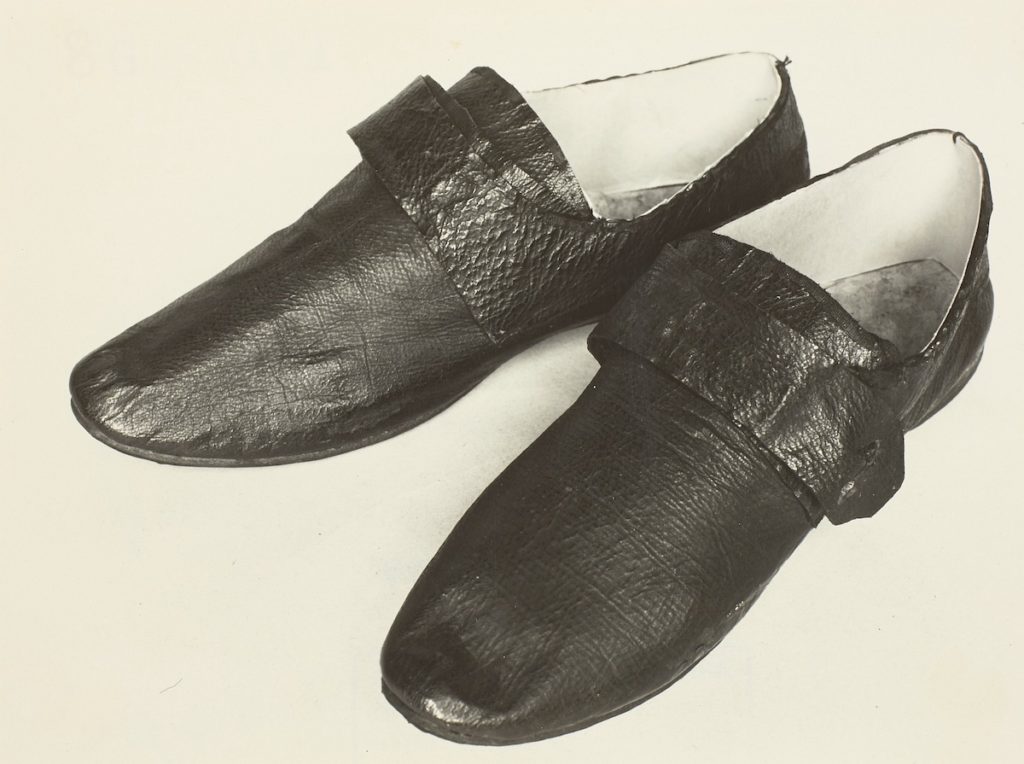
Among the nearly 600 artifacts, leaning as one would expect toward German artists and material culture, was a pair of Immanuel Kant’s shoes (Fig. 1)—a humble relic of the thinker routinely represented with Buddha, Socrates, and Confucius in the Chinese “four sages” portrait genre of the late nineteenth century, and a hint to the embodied nature of his thinking on his notoriously punctual walks around Königsberg. Alongside these mute witnesses, visitors were confronted with Kant’s bust, inscribed with a motto from his 1784 answer to the newspaper query “What is Enlightenment?”: “Have the courage to use your own understanding!” (Fig. 2).[6] This injunction is linked to Kant’s own answer, based on an analysis of public discourse and media: enlightenment is “the public use of one’s own reason” in the service of “emergence [or escape] from one’s self-induced immaturity.”[7] The coexistence of liberal ideas with an authoritarian regime, which critics of the Beijing exhibition were quick to exploit, is no betrayal of the Kantian notion of Enlightenment, not if we recall his tongue-in-cheek reply to public intellectuals on behalf of enlightened despot Friedrich the Great: “Argue as much as you like and about whatever you like, but obey!”[8]
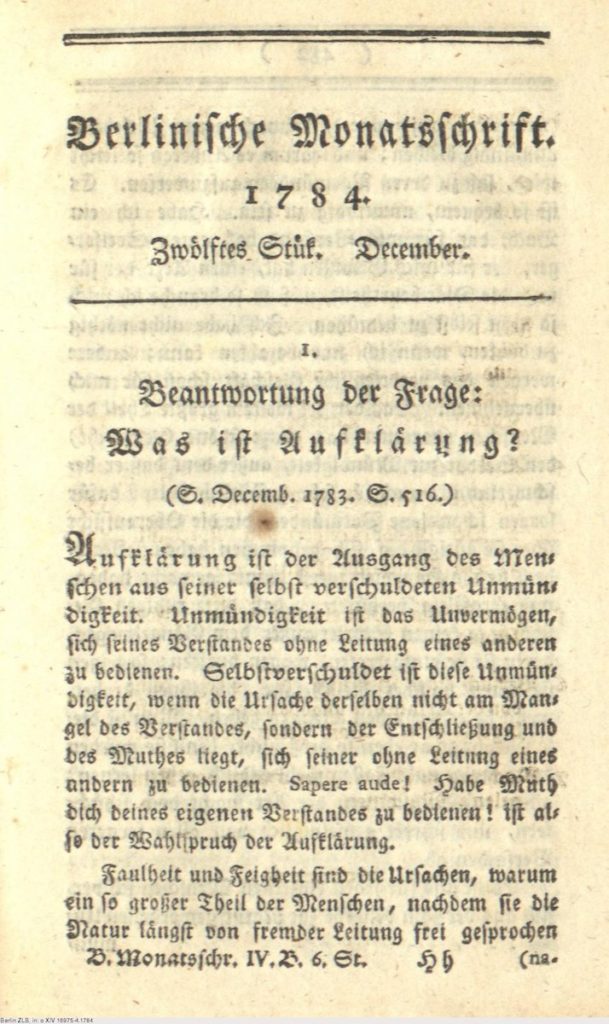
That hardly sounds like promising soil for utopia. But what is interesting, then and now, is the pragmatism of Kant’s account, his view of Enlightenment not as a finished cultural product or distant ideal but as a process—as Michel Foucault was to revive it two centuries later, the modernist project of knowing the present, “the difference today introduce[s] with respect to yesterday.”[9] A functional attitude, embodied in the rhetoric of escape from a self-imposed problem (of which there are so many today, from climate change to mass incarceration) makes Kant’s formulation of Enlightenment exciting for activist intellectuals wary of grand political engineering, as Foucault was. It might also suit art historians and critics willing to ask what Ai Weiwei’s blog or a sprawling eighteenth-century novel like The Dream of the Stone might have to do with processes of Enlightenment, understood as more than just an importation of European secular political ideas.[10] But of course there are difficulties transposing Kantian enlightenment to art. Its concept of publicity projects as its opposite an exoticized, feminized, infantilized, but at any rate unexamined notion of privacy.[11] Equally problematic may be the attendant image of the Kantian aesthetic subject, “the mobile and discerning observes, the man of freedom […] a category that excluded enslaved and exploited peoples, indigenous peoples, colonized peoples, women of all races, and the criminalized.”[12] Is there a way to exhibit a Kantian self-reflexive Enlightenment in painting apart from conspicuous display of (or concealed) privilege?
I think there is, but to see it, we have to abandon not just the anthropological assumptions and racist pseudo-science undergirding Kant’s more comparative work, but the very contrast between public and private as spheres of mature and immature, articulate and inchoate reason.[13] The “public use of reason,” which sounds so forthright in Kant’s examples—an officer obedient to the chain of command but publishing a critique of military policy, a priest who leads his flock and in his spare time criticizes its theological symbols—may be expressed in a nuanced play of mood and inflection, a movement of eyes and hands.[14] These participate in modes of life to which public reasoners belong, whether they are articulated in print or not. Indeed, they may be articulated retrospectively, contributing to long-range processes of enlightenment.
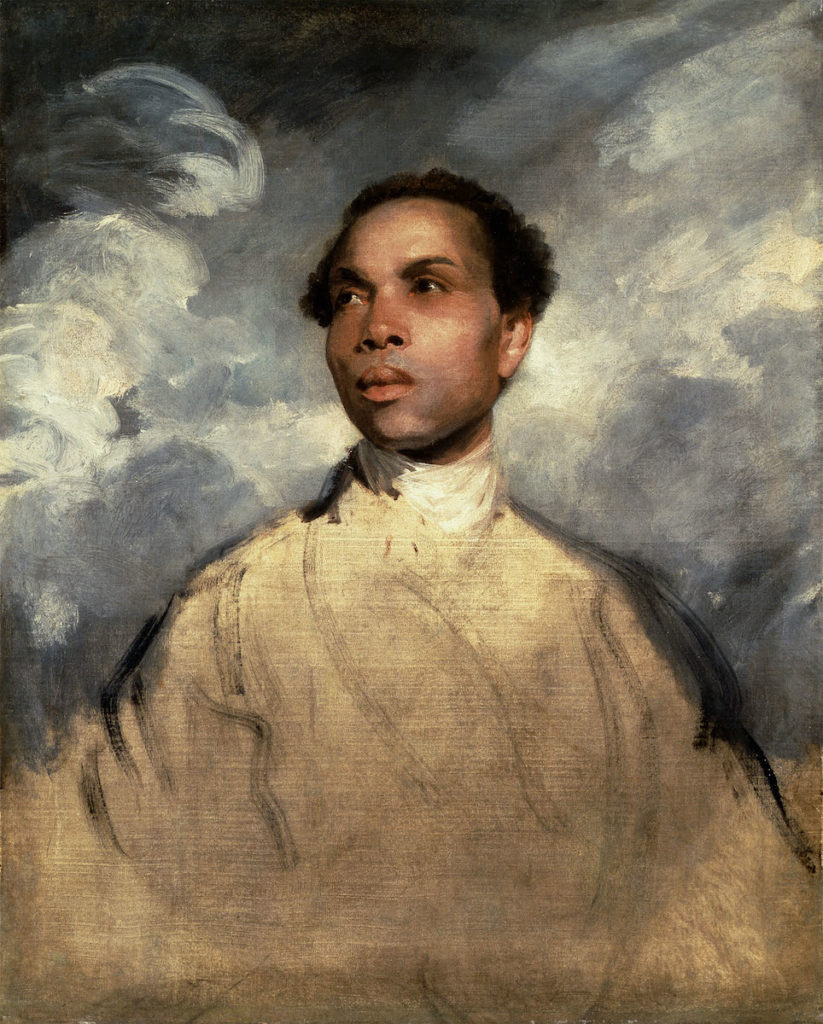
We can experience the compatibility of subtlety and clarity in the public use of reason by turning to an object whose content is less fixed for us than the texts of Kant’s public reasoners. That is the portrait of the so-called Young Black Man painted around 1770 by Sir Joshua Reynolds, though we will have reason to question both the date and title (Fig. 3). For the past two centuries, the portrait has been reputed to represent Francis Barber, Samuel Johnson’s freed Jamaican servant, who at Johnson’s death was named residual legatee, and eventually opened a school in Johnson’s hometown of Lichfield. Though the original painting, now in the Menil Collection in Houston, is unfinished—a state which might itself prove significant—it became a paradigm, with at least five known copies in oil and watercolor in public collections like the British Museum, Tate Britain (two copies), and Victoria & Albert Museum, the Samuel Johnson Birthplace Collection in Lichfield, and the Dr. Johnson House on Gough Square in London.[15] Most notable aesthetically is the copy in the V&A (Fig. 4), attributed pretty firmly to portrait miniaturist Henry Edridge (1769-1821), who entered the Royal Academy schools in 1784 and copied a number of Reynolds portraits prior to the elder artist and RA president’s death in 1792.[16] The work’s popularity with copyists may speak to its singular subject matter and its unfinished state: the strikingly self-possessed image of a Black man, deprived of any identifying markers, the lower body blocked in broadly, as if inviting emulation and completion.[17]
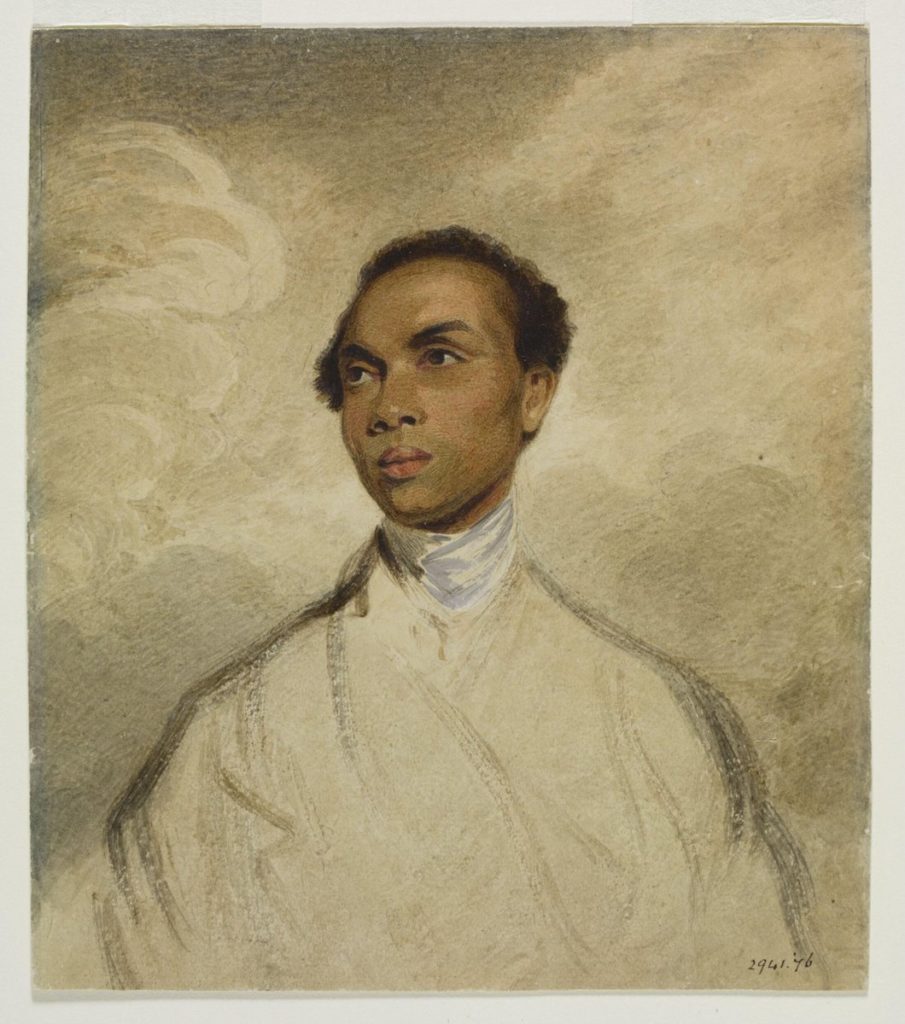
If the presence of one of the copies in the Johnson House seems to reinforce the anecdotal identification of the sitter as Francis Barber, it is important to acknowledge that no eighteenth-century inscriptions are extant, so curators now often identify the sitter as Reynolds’s freed Black servant, about whom even less is known: not even his name has been preserved.[18] We have the word of James Northcote, Reynolds’s pupil and first biographer, that Reynolds had this servant “pourtrayed in several pictures, particularly in one of the Marquis of Granby, where he holds the horse of the general.”[19] No claim is made that Reynolds painted his servant as an individual, and a comparison with the Granby portrait, which was widely reproduced (Fig. 5), hardly lends support to the hypothesis—we see here a generic Black page, decades younger than in the purportedly contemporaneous Menil sketch, his face just visible over the horse’s flank. Could this figure have been “abstracted” from the more concrete and personalized rendering of the man’s features in the idealizing manner Reynolds recommends to history painters in the Discourses on Art he delivered at the Royal Academy? “An History Painter paints man in general; a Portrait Painter, a particular man, and consequently, a defective model.”[20] Reynolds goes on to warn portrait painters attempting more ambitious work not to “enter too much into the detail.”[21] The suggestion that he would therefore carefully transcribe his employee’s features before editing them out in the definitive work is therefore somewhat tenuous.
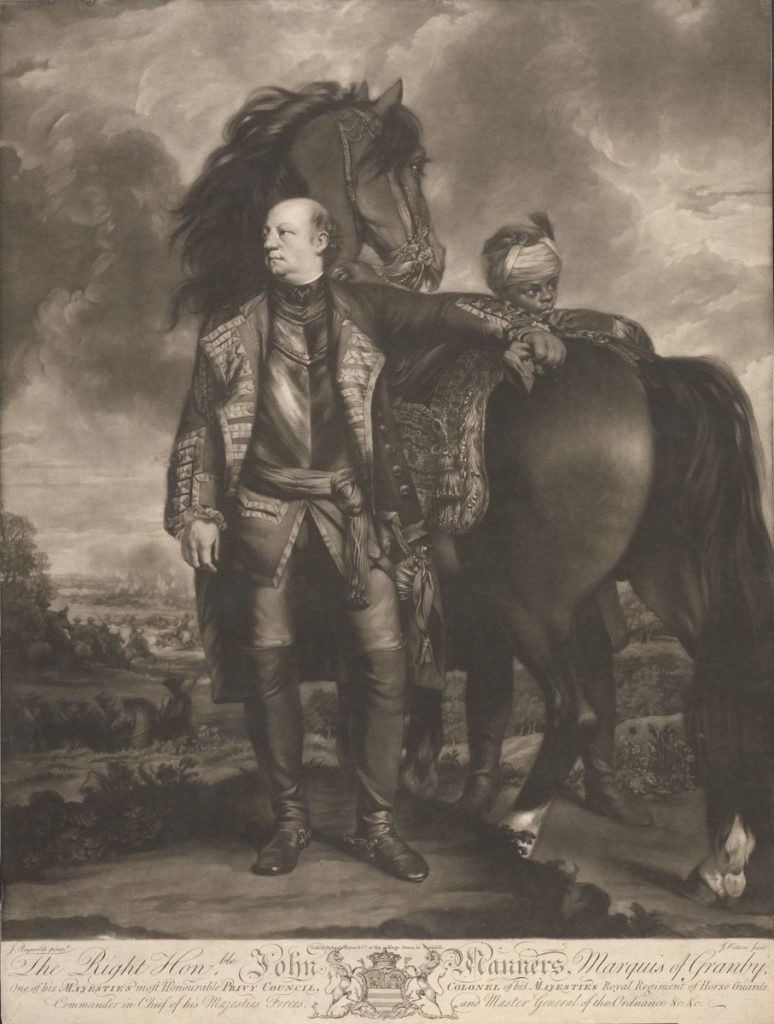
The written evidence that Reynolds was painting his own servant is also indirect: the fact that the 1813 British Institution retrospective mounted by Sir George Beaumont, who owned the painting, listed the work as “The Black Servant of Sir Joshua” (no. 140). In his excellent 2015 biography of Barber, Johnson House Trust director Michael Bundock takes this as decisive, for Beaumont “had known Reynolds well and was in a position to say whether the picture was of his servant.”[22] All of this would indeed be significant, if we knew that Beaumont, Northcote or Reynolds took this particular person or persons, that is, the single Black man portrayed in the portrait and the single Black man employed by Reynolds, seriously as an individual whose individuality is worth recording intentionally. There is interesting anecdotal evidence, retailed by Northcote, that Reynolds’s servant, who is never named in all the records of this prominent household, was not accorded such respect: once, after staying out late and having to sleep in a poorhouse, and having his watch stolen and the culprit caught, Reynolds’s servant was ordered by his master to bring food and drink to a man condemned to death for stealing his watch, “as a penance as well as an act of charity.”[23] It is a difficult bit of moral calculus to ask, on the basis of this anecdote, which Northcote retails with approval, whether Reynolds could have painted his servant with the respect and sympathy evident in the Menil portrait.[24]
Fortunately, there is a blunter item of negative evidence, in the form of another copy of the same portrait also by Henry Edridge, this one in the British Museum. The inscription on this one, more authentic than that in the V&A, reads “From the Original Picture / of a Blacks Head / by Sir Joshua Reynolds / in the possession of / Sir Geo: Beaumont / by Henry Edridge / April 1808.”[25] So five years before the first public showing of the painting, at least, there was no firm identity attached to the original, and Beaumont’s specification of a sitter for the retrospective is likely to have been guesswork with no extraordinary authority.
If the subject of this painting is not firmly fixed, a twenty-first-century reading cannot simply approach it as a technical problem of attribution and provenance, but must reflect on the intersection of race with anonymity, either at the work’s source or subsequently, or both. Not that loss of identifying labels is exceptional in portraiture—nor is the practice of fantasy portraits and individual genre pictures, called by the Dutch “tronies,” which despite being painted from a live model are meant to be typical rather than individual.[26] The reception history of Reynolds’s painting does betray a treatment of the Black man portrayed as typical or generic—but we cannot assume this was its initial condition without closer examination of the picture and the written record. The erasure of Black subjects from the history of art and of eighteenth-century British life generally is a fact, but to take it for granted only exacerbates its occluding effects.[27]
Barring fresh empirical evidence that might still turn up and decisively alter our understanding of the Menil portrait’s subject, we may proceed cautiously, taking the dearth of information, and its unreliability, as a telling part of the historical record in need of explanation. It can help us plumb the gap between the regard needed for the production of a portrait, any portrait, and one as remarkable as the Menil canvas in particular, and the various modes of neglect and dismissal with which their contemporaries and posterity have treated Barber, Reynolds’s unknown servant, and the sitter of the Menil portrait, to whatever extent these individuals diverge or overlap.
Why keep Barber in the mix at all? Because of one tantalizing scrap of positive written evidence. Reynolds’s pocketbooks, wherein he noted portrait sittings as well as a plethora of social calls, bear witness to an 1767 appointment with “Franks”, which to nineteenth-century biographers seemed proof positive that Barber, whom familiars called Frank, sat for the painter.[28] In the 1986 Reynolds retrospective, Nicholas Penny dismissed this idea, pointing out that around this time Reynolds painted members of the Franks family.[29] But that is not the last word on the entry. Although he leans toward Beaumont’s theory that the portrait is of Reynolds’s servant, Bundock has incidentally demolished Penny’s argument, pointing out that Reynolds was always impeccable in outfitting his customers with the correct honorific: members of the Franks family were “Mr., Mrs., Miss” Franks, depending on who was sitting. Moreover, the wealthy Franks finished their sittings in 1766, a year before the mysterious, errant “Franks” notation.[30] Could a misprint on Reynolds’s part, a mangled “Frank” or “Francis”, bear witness to a sitting on Francis Barber’s part? Bundock thinks it unlikely that Reynolds would have bothered to mark down the coming of his friend Johnson’s valet, but even he is forced to concede that if the entry refers to Barber, then “it probably does indicate a sitting for a portrait.”[31]
That might seem a tortuous line of reasoning to arrive at the unexciting conclusion that the documentary case remains open, but the very arduousness of the path—scholars and curators’ insistence that the portrait cannot be Barber, and recrudescence of the possibility—indicates the nature of the difficulty.[32] To put it simply, the skill displayed in the execution and the quiet confidence and dignity the portrait appears to attribute to the sitter tip the scale of plausibility toward the Menil sketch being no genre study but an explicit portrait, a picture that “looks to us like a portrait…even if we do not know the person portrayed.”[33] And so Barber remains the most attractive candidate in part because of the complexity and intrinsic interest of his person.[34] We should acknowledge this attraction, however cautiously, as we take a closer look at the painting.
To begin with: are the contingencies of the painting’s facture and the physiology of the sitter consistent with that sitter being Barber? Are we really looking at a person of twenty or twenty-four, as Barber would have been depending on conflicting reports of his birthdate? The year of Reynolds’s “Franks” entry, 1767, Johnson sent Barber away to school in rural Bishop’s Stortford to train him to be his literary secretary. Johnson addressed his letters there to “Francis”, and a hatter’s order book in the Hertfordshire Archives records that “Mr. Barber” bought a hat for 6 shillings and 9 pence in 1769.[35] Was our sitter Mr. Barber to a hatter, Francis to Dr. Johnson, and Frank to Joshua Reynolds? To which of these socially inflected nominata might the canvas correspond? We cannot say with certainty how Reynolds would have filled in the lower half of the canvas, whether the elegantly cut coat would have the telltale braids and stitching of servant’s livery.[36] But the sunlight shining on his forehead and clouded sky around him place him outdoors, tightly framed, where it would be difficult to show him fulfilling a valet’s duties. The green-black wisps around his shoulders may have been pinned down as trees, but there is little hope of placing him in a recognizable property. Andrea Bayer is surely right to note that the “stormy sky…accentuate[s] the drama of the presentation,” but this device was a mannerism of Reynolds’s, which he applied also to his bombastic self-portrait with a bust of Michelangelo, or for that matter to the delicate Portrait of Miss Franks now in the Joslyn Art Museum (Fig .6).[37]
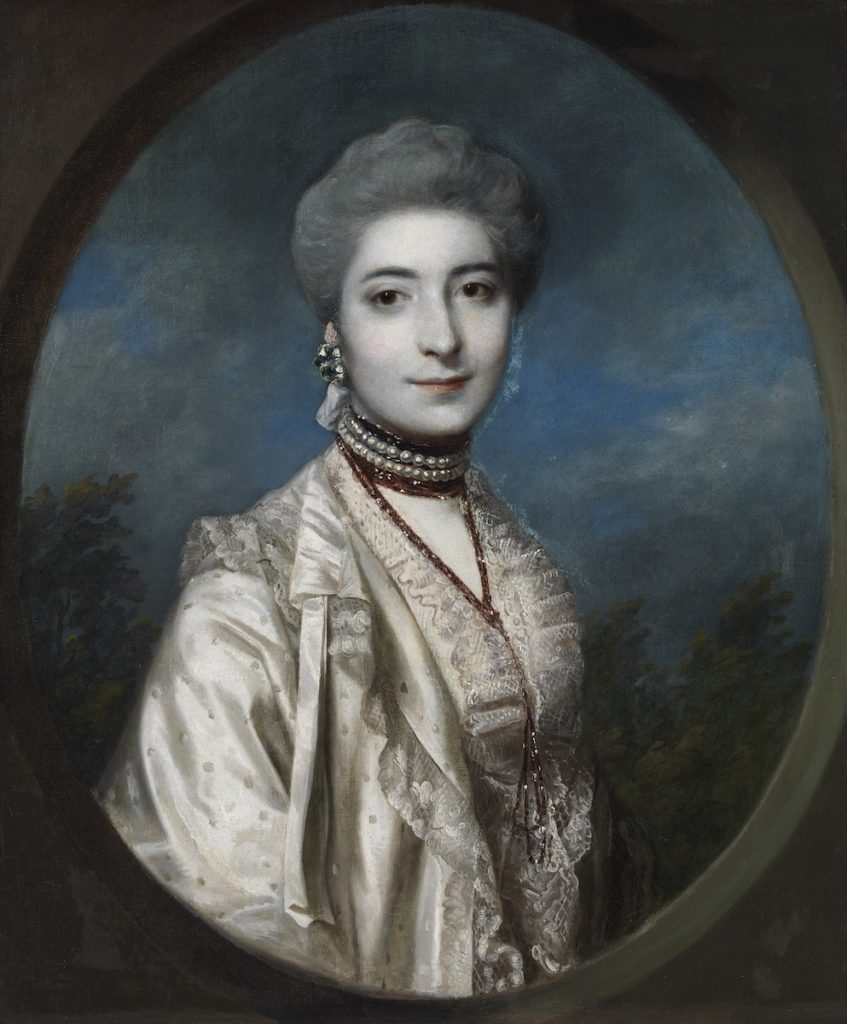
In contrast to such status seekers or holders, Reynolds’s Black sitter, who need not necessarily have been “young,” looks up and away, in an attitude of thought. Since we lack the context that documentation and finishing touches could furnish, it may be best to compare the work with analogous gambits, whether in portrait or narrative settings. Among portraits of celebrated Black Britons, Thomas Gainsborough’s confirmed Portrait of Ignatius Sancho of 1768, influentially engraved by Francisco Bartolozzi for Sancho’s 1782 memoir, is as remarkable for its quiet sartorial elegance as for a nineteenth-century notation by its former owner recording its quick execution in “one hour and forty minutes,” a feat consistent with an informal commission by Gainsborough and Sancho’s powerful patron, the Duchess of Montagu (Fig. 7).[38] This is exactly the kind of thing we don’t know about Reynolds, but the pictures have the apparently calm, self-sufficient thoughtfulness of their sitters in common. Though both look off to the left, Gainsborough’s sitter does so at nearly a 90 degree angle to the viewer’s gaze, as if engaged in conversation by an interlocutor. Reynolds’s sitter, by contrast, looks out obliquely left and up, and our own viewing position somewhat below suggests that what he is surveying, if he in fact rests his gaze on any object, is a landscape continuous with the one we see. The high ratio of sky to (provisional) greenery, in contrast to Gainsborough’s monochrome brown background, serves to emphasize the sitter’s head, which does not smile or frown or otherwise enact social gestures: it does nothing but think. One might be reminded of Allan Ramsay’s flamboyantly turbaned or behatted philosophers (David Hume and Jean-Jacques Rousseau), whose headgear and bold stares mime serious, challenging thought; but Reynolds’s sitter pays no attention to the viewer whatsoever.[39]
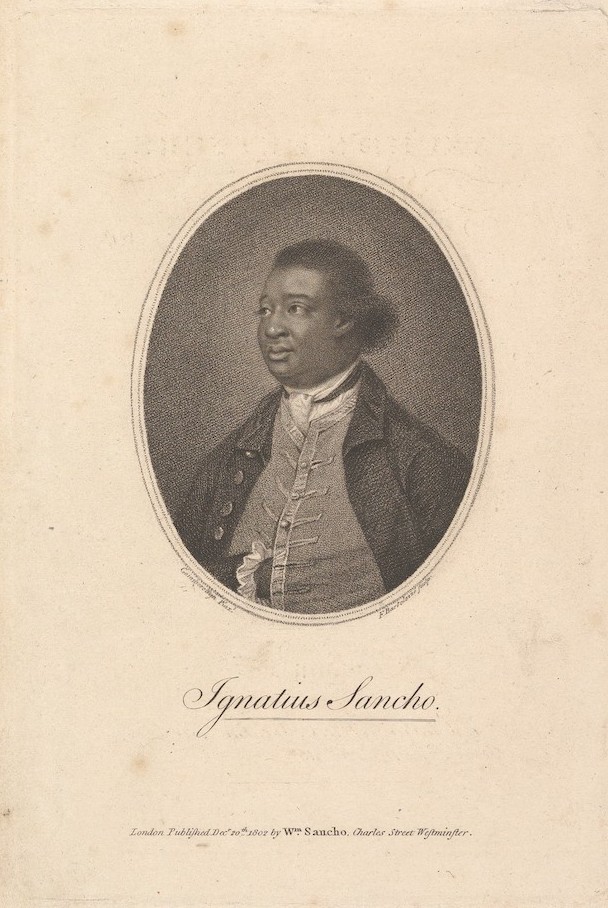
Since our subject is the long reach of Enlightenment, less historicist comparisons are possible. Take a painting of a male Black subject projecting an overwhelming melancholy, John Philip Simpson’s Captive Slave (Fig. 8). Though the work of a portraitist (Simpson exhibited four other portraits, three named, at the Royal Academy in 1827), this painting, beside its descriptive title, bore as caption in the catalogue an excerpt from Charity, an abolitionist poem by William Cowper.[40] The final lines of this, significantly, evoke the social death endured by the enslaved: “The tender ties of father, husband, friend, / All bonds of nature in that moment end; / And each endures, while yet he draws his breath, / A stroke as fatal as the scythe of death.”[41]
The shock value of the image is as vivid today as when it was painted, six years before the final abolition of slavery in Crown colonies. As law scholar Farah Peterson notes in a very recent and incisive piece of political art criticism, “To the modern eye, the slave’s smock …stretches forward in time to suggest orange prison scrubs, an allusion the artist could hardly have anticipated, but one that gives the portrait enduring resonance.”[42] The work’s probable sitter, famed free Black American actor Ira Aldridge, made a career challenging and confirming racial stereotypes, playing Shakespeare but also deigning to take on dialect minstrelsy and the “stilted symbols” Simpson foisted on him.[43] It is hard not to read a conflict between complex individual and pious messaging in how the body language (the hands with their firm, anxiously splayed fingers) is subordinated to a hopeful gaze up and out of the picture to the right, in the direction of a subtly barred light source likely meant to indicate a prison window or slave ship porthole. It is as if this light source doubles symbolically as the harbinger of divine providence, denied bodily to the shackled slave, who nevertheless yearns for it.[44]
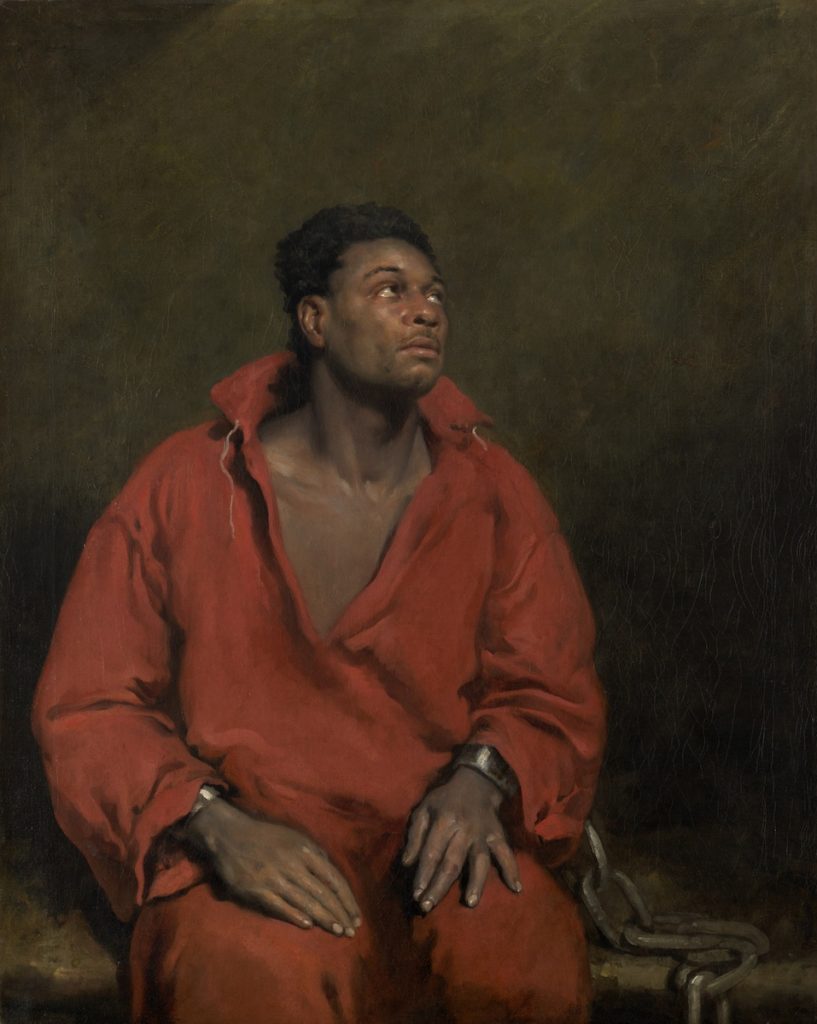
In comparison, Reynolds’s subject is more measured, his body at ease, his mouth set but responding less to current disaffection than quietly drawing our attention to the play of thought carried by eyes gazing into the distance. The effect of concentration, achieved with eminently theatrical means in the portrait of an actor by Simpson, is as intense in the earlier portrait, but achieved by other means: as much by the animation of the cloudy sky in Reynolds as it is by the figure’s reserve and dearth of gesture or facial expression.[45] Only the conspicuous white highlights on both eyes might betray emotion, externalized in the form of tears—but these, in the absence of gestural or facial giveaways, are as likely the result of wind in the eyes. Yet, if the content of his thoughts is decidedly not made transparent to us, the visibility of his cogitation in his reflective features qualifies his portrayal as the image of a public exercise of reason.[46]
Readers recalling the overlapping if not identical uses of “public” by Kant, Habermas, Foucault, and other theorists, may object that I have left unclear in what sense either Reynolds’s sitter or his act of thinking deserves the adjective. Twenty-first-century viewers are uncertain of the man’s identity; Francis Barber counted as a public figure, and a controversial one, in the year following Samuel Johnson’s death, as several friends and memoirists jockeyed for position.[47] Be that as it may, we are not given to see a dramatic enactment of this public role, not even in the implicit manner in which Aldridge the free Black actor might be viewed as undertaking the dramatic role of (an all too plausible) captive slave in Simpson’s painting some decades later.
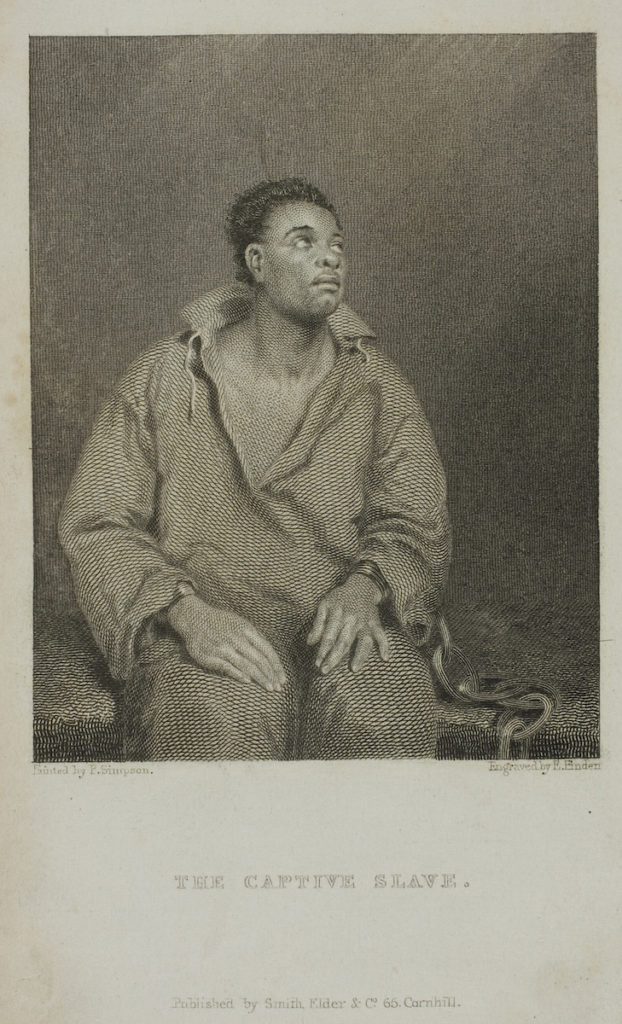
Yet is the contrast clear-cut? Recall that Simpson made no reference to Aldridge in the initial “publication” of the painting in the 1827 RA exhibition; nor is he mentioned in the coeval reproductive engraving, which accompanied another, anonymous poem imagining a slave ship going down off the coast of Senegambia (Fig. 9).[48] This anonymity may be explicable by Aldridge’s own strategy, in his early British touring days, of calling himself the “African Roscius” or “Keene” after great actors of the previous generation (and antiquity).[49] In any case, the first explicit identification of the sitter with the actor came in a 1975 letter held by the Tate, which owns a study of the same sitter, indeed of the same sitting (Fig. 10; note, in particular, the identical posing and anatomy of the exposed clavicle), not yet determined narratively as a captive slave.[50] Here too we have the thoughtful gaze and set stoic mouth more characteristic of Reynolds’s unfinished portrait than of Simpson’s final composition.[51] Whether Simpson intended a mere character study in the “Black man and clouds” paradigm we have discussed, or the regal robe was meant to allude to a role like Othello or Oroonoko, it is the sitter’s reserve, his withholding of his thoughts, including any reaction to whatever he is gazing upon, that is communicated to us. Which, I submit, is to say made public. The provision of a name and career, intrinsic to the causation of these paintings, was by no means crucial to their reception—as Agnes Lugo-Ortiz and Angela Rosenthal eloquently put it, “if we do see Aldridge, it is in part despite, not because of, the painting’s genre.”[52] The same, I submit, is true of Barber: in both cases, the subject’s thinking, not its contents nor its consequences, is boldly on display.
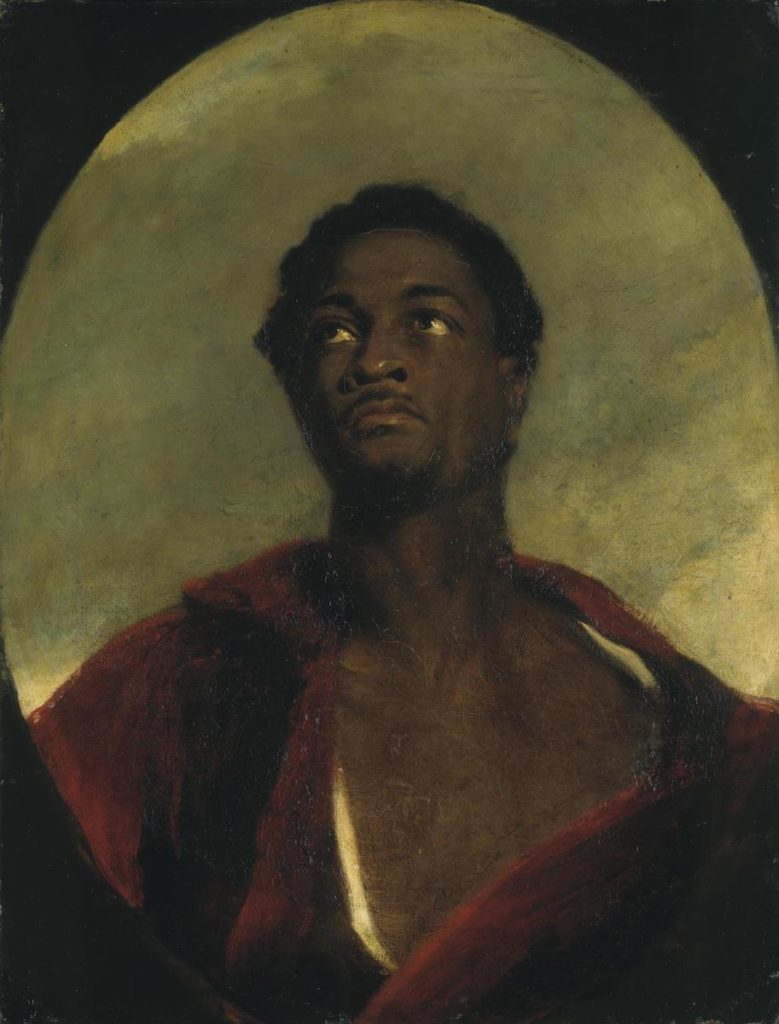
Where does the conceptual space opened between Kant’s injunction to think publicly and the era’s thinker-portraits leave the Reynolds painting that Tate and National Gallery still call the Young Black Man? [53] In physical terms, he looks rather like a mature man who has seen much, resolute but hardly naive: perhaps a Francis Barber shortly before or after Johnson’s demise, for whatever reason unable or unwilling to complete his portrait sitting. Even should such speculation turn out to be untenable, we can say confidently that Reynolds has painted him, whoever he is, lost in his own thought, and in showing him thus to us, he has left us arguably his only portrait of a person using reason publicly, and doing nothing else. But this should not be a triumphant conclusion, so much as one showing how much remains to be done. It is no accident that Kant’s stinging negative definition of Enlightenment as exit from “self-induced immaturity” has interested both advocates of public reason like Foucault and Habermas and critics of the neoliberal university like Stefano Harney and Fred Moten.[54] It reads uncomfortably applied to a Black man who began life enslaved and was emancipated into the only partly free status of servant, paid a wage but not free to pick up and leave at will, attending grammar school in his late twenties and achieving personal and financial independence only upon Johnson’s death, when he was nearing fifty years of age.[55] The lack of empirical autonomy faced at practically every juncture of his life by Francis Barber, or by any other human being whom this painting might have represented, was not self-imposed in the sense Kant applied to his Berlin readers in the year of Johnson’s death, 1784. That makes his presence in Reynolds’s unfinished canvas an uneasy one. But he is by no means incomplete in terms of his own activity, which in this painting is, unambiguously, an intellectual one. If the Enlightenment remains unfinished business, in this portrait it is also very much underway.
Andrei Pop is a Professor in the Committee on Social Thought and the Department of Art History at the University of Chicago, IL
Acknowledgments: This article improved thanks to the advice of Sussan Babaie, Maggie Cao, Esther Chadwick, Meredith Gamer, Bart Pushaw, two anonymous readers, and especially editors Sarah Betzer and Dipti Khera. At the University of Chicago, I owe intellectual debts to Agnes Lugo-Ortiz, Tina Post, Eric Slauter, and my research assistant Mahria Baker, who is also responsible for many of the text’s virtues.
[1] The question is more promising than it seems: anyone reading Dipti Khera’s Place of Many Moods: Udaipur’s Painted Lands and India’s Eighteenth Century (Princeton: Princeton University Press, 2020) becomes aware that the period was one of transformation outside of Europe, with and independently of European colonial presence.
[2] Ernst Cassirer, Die Philosophie der Auflkärung (Tübingen: Mohr, 1932), translated into English as The Philosophy of the Enlightenment (Princeton: Princeton University Press, 1951); Walter Friedlaender, Hauptströmungen der Französischen Malerei von David bis Cézanne : vol.1, von David bis Delacroix (Bielefeld and Leipzig: Verlag von Velhagen & Klasing, 1930), translated as David to Delacroix (Cambridge, Mass.: Harvard University Press, 1952); Edgar Wind’s “Humanitätsidee und heroisierte Porträt in in der englischen Kultur des 18. Jahrhunderts,” in England und die Antike, Vorträge der Bibliothek Warburg 1930-31 (Leipzig: B.G. Teubner, 1932), 156-229, translated as Hume and the Heroic Portrait: Studies in Eighteenth-Century Imagery, ed. Jayne Anderson (Oxford: Clarendon, 1986), 1-52; Emil Kaufmann, Von Ledoux bis Le Corbusier (Vienna: Passer, 1933; going back in part to a 1920 Universität Wien dissertation), translated as “Three Revolutionary Architects: Boullée, Ledoux and Lequeu,” Transactions of the American Philosophical Society 42:3 (1952), 431-564.
[3] This history has yet to be written; critiques of Enlightenment as constitutive of worldwide colonial systems of domination include Gayatri Chakravorty Spivak, A Critique of Postcolonial Reason (Cambridge, Mass.: Harvard University Press, 1999); and Kandice Chuh, The Difference Aesthetics Makes: On the Humanities “after Man” (Durham: Duke University Press, 2019). See also Genevieve Lloyd, Enlightenment Shadows (Oxford: Oxford University Press, 2013), which stresses the skeptical, aporetic dimension of this movement.
[4] Thomas Crow, Painters and Public Life in Eighteenth-Century Paris (New Haven: Yale University Press, 1985); John Barrell, The Political Theory of Painting from Reynolds to Hazlitt: ‘The Body of the Public’ (New Haven: Yale University Press, 1986).
[5] I use the term “blockbuster” to refer to the scale of the enterprise, which involved the Staatliche Museen zu Berlin, the Staatliche Kunstsammlungen Dresden, and the Bayerische Staatsgemäldesammlungen München, featured 579 loan items spread over 190,000 m2 in nine rooms of the newly reopened National Museum and cost German taxpayers 6.7 million euros. In a Real Clear Arts column, Judith Dobrzynski pointed out that the yearlong total of 450,000 visitors was modest by Chinese standards; the Shanghai Museum’s show of Maori Treasures the same year reached over 600,000 visitors in three and a half months’ time. “The Art of Enlightenment ends in Beijing, with a whimper?” artsJournalblogs, 2 April 2012, https://www.artsjournal.com/realcleararts/2012/04/the-art-of-the-enlightenment-ends-in-beijing-with-a-whimper.html, accessed 4 January 2021 (unless otherwise noted, all online articles have this access date).
[6] This bust, placed at the entrance in the eighth portion of the show, “Emancipation and the Public Sphere,” is discussed by the appropriately anonymous correspondent T.P. in “Love the art, forget the ideas,” The Economist, 7 April 2011, https://www.economist.com/prospero/2011/04/07/love-the-art-forget-the-ideas; see also Jonathan Derbyshire, “Let there be light,” New Statesman, 5 May 2011, https://www.newstatesman.com/art/2011/05/china-enlightenment-kant. Both Derbyshire and T.P. note the arrest of Ai Weiwei on April 4 of that year: prior to his silencing, the artist had already made skeptical comments about the timing and politics of the show.
[7] Immanuel Kant, An Answer to the Question: “What is Enlightenment?”, trans. H.B. Nisbet (London: Penguin, 2009), 3.
[8] Ibid. Kant’s shoes were mentioned by many critics of the exhibition and the Chinese government, e.g. Gereon Sievernich, “Liu Xiabo, Ai Weiwei und die Schuhe Kants,” Der Tagesspiegel, April 9, 2011, online at https://www.tagesspiegel.de/kultur/aufklaerung-liu-xiaobo-ai-weiwei-und-die-schuhe-kants/4043430.html
[9] Michel Foucault, “What is Enlightenment?” in Paul Rabinow, ed., The Foucault Reader (New York: Pantheon, 1984), 32-50, this quote 34.
[10] Cf. Wei Zhang, What is Enlightenment: Can China Answer Kant’s Question? (Albany: State University of New York Press, 2010), which connects Kantian with a “Confucian Enlightenment”. Foucault gestured toward this cultural flexibility in noting that Kant’s answer made contact with Moses Mendelsohn’s response to the same question, connecting German philosophy with the Haskalah (Jewish Enlightenment).
[11] Thus Lisa Lowe, The Intimacies of Four Continents (Durham: Duke University Press, 2015), 28: “We can trace this narrative of the modern individual, or Western man, who possesses interiority of person, as well as a private household, in the political philosophical tradition from Locke and Rousseau to Kant and Hegel.” Lowe proceeds to examine not just the exclusions of those accordingly relegated to the outside of reason, but the problematic transformation of putatively private experience into public goods in autobiographical writings and slave narratives.
[12] Nicole R. Fleetwood, Marking Time: Art in the Age of Mass Incarceration (Cambridge, Mass.: Harvard University Press, 2020), 29. Fleetwood is cautious in contrasting this vision of the aesthetic subject with the carceral subjects (and aesthetics) that are her focus, but her reviewer Nijah Cunningham, “With Each Other,” Art Journal 80:3 (Fall 2021), 123, may be right in sharpening the conclusion to the point that, according to Kant, “the incarcerated artist is categorically impossible.” The question then follows whether such artists, who existed even before Kant’s time, are “non-aesthetic” subjects of some sort, or whether our account of aesthetics should change. I hope it is clear that the latter option is more appealing to me, as it is to Chuh, whom Fleetwood cites.
[13] On the anthropological aspects of race theory, and its bearing on art, see David Bindman, Ape to Apollo: Aesthetics and the Idea of Race in the 18th Century (Ithaca: Cornell University Press, 2002); and Anne Lafont, L’Art et la race: L’Africain (tout) contre l’œil des Lumières (Dijon: Les Presses du réel, 2019).
[14] Again, readers of Khera’s book, or of Arindam Chakrabarti’s introduction to the Bloomsbury Research Handbook of Indian Aesthetics and the Philosophy of Art (London: Bloomsbury, 2016), might agree that a rasa aesthetics of conceptualized atmospheric mood is as much a helpful tool of Enlightenment art history as, say, social art history.
[15] The painting’s unfinishedness led to recent attention in the context of The Metropolitan Museum of Art’s 2016 Met Breuer exhibition Unfinished. See Andrea Bayer and Nicholas Cullinan, “Portraiture and the Question of Focus,” in Kelly Baum, Andrea Bayer, and Sheena Wagstaff, eds., Unfinished: Thoughts Left Visible, exhib. cat. (New York: The Metropolitan Museum of Art; London and New Haven: Yale University Press, 2016), 102 and 314.
[16] The Menil original was sold, with Reynolds’s collection, by the auction house Greenwood’s in 1796, to Sir George Beaumont, a friend of the artist. Edridge’s copy in the V&A has inscribed on its back “H. Edridge. From a picture by Sir J. Reynold [sic], in the Collection of Sir G. Beaumont.” The perfunctory style, spelling error and order of names suggests a late inscription, likely connected to the entry of the drawing into the South Kensington Museum (the original name of the V&A) in 1876. See https://collections.vam.ac.uk/item/O136626/portrait-of-francis-barber-watercolour-edridge-henry/.
[17] It may be significant that the least accomplished oil copy, in the Dr. Johnson House collection in London (presented by Cecil, Lord Harmsworth), has pretensions of completeness; it turns the blocked-in overcoat of the original into a kind of yellow smock. See https://artuk.org/discover/artworks/portrait-of-an-unknown-man-50482.
[18] Nicholas Penny first made this argument in his 1986 catalogue to the Royal Academy exhibition (see below). It is followed by Andrea Bayer in Unfinished, and by Esther Chadwick and Meredith Gamer in the text to their 2014 Yale Center for British Art exhibition Slavery and Portraiture in Eighteenth-Century Atlantic Portraiture, Figures of Empire (https://britishart.yale.edu/sites/default/files/inline/Figures%20of%20Empire_booklet_FINAL.pdf, 27).
[19] James Northcote, The Life of Sir Joshua Reynolds, 2 vols. (London: Henry Colburn, 1818), 1:204.
[20] Joshua Reynolds, Seven Discourses Delivered in the Royal Academy by the President (London: T. Cadell, 1778),138 (fourth discourse, delivered December 10, 1771). The passage is famously attacked in E.H. Gombrich, Meditations on a Hobby-Horse (London: Phaidon, 1963), 2.
[21] Reynolds, Seven Discourses,138.
[22] Michael Bundock, The Fortunes of Francis Barber (New Haven and London: Yale University Press, 2015), 217. Bundock also reiterates Northcote’s reference to “several pictures.”
[23] Northcote, The Life of Sir Joshua Reynolds, 206; and Bundock, The Fortunes of Francis Barber, 101-105.
[24] Bundock in The Fortunes of Francis Barber asks: “Would the story have been the same had the thief been black and the servant white?” (104), before concluding: “The episode illustrates the difficulty in trying to judge, with all the benefits of hindsight, how much issues of colour influences behaviour towards any individual, a difficulty which also affects our understanding of the life of Francis Barber” (105). I agree, but would add that the episode at any rate should make us skeptical that an individual granted so little attention qua individual as Reynolds’s servant could be the sitter of this portrait.
[25] For details on the object, see https://www.britishmuseum.org/collection/object/P_1891-0511-36, accessed 27 April 2021. The very careful watercolor differs only slightly from the V&A copy, being in a slightly longer format (194 x 144 mm as opposed to 170 x 145 mm), including more blank paper below the sitter’s lapels and sleeves.
[26] The literature on fantasy and quasi-portraiture is vast: on the narrower Dutch phenomenon, see Frederic Schwartz, “‘The motions of the countenance’: Rembrandt’s early portraits and the tronie,” RES 17-18 (Spring-Autumn 1989), 89-116; and, for a book-length treatment, Dagmar Hirschfelder, Tronie und Porträt in der niederländischen Malerei des 17. Jahrhunderts (Berlin: Gebrüder Mann, 2008). Interestingly, it is possible for a portrait to “become” a tronie through overpainting, as in the case of Frans Hals’s portrait of the preacher Verdonck, painted wielding a jawbone (a satirical reference to his aggressive polemics), which a later restorer metamorphosed into a wineglass. See Seymour Slive, Frans Hals, 3 vols. (London: Phaidon, 1970) 1:81-83.
[27] It has done so before, notably the picture long thought to be of Olaudah Equiano in the Royal Albert Memorial Museum, Exeter (RAMM), which is probably a portrait of Ignatius Sancho. See John Madin, “The Lost African: Slavery and Portraiture in the Age of Enlightenment,” Apollo (August 2006), 34-39, and the exchange between Madin and Paterson Joseph on ArtUK, https://artuk.org/discover/stories/the-outrageous-neglect-of-african-figures-in-art-history and https://artuk.org/discover/stories/john-madin-responds-to-paterson-josephs-article. See also Andrei Pop, “The Importance of Being Oroonoko: An Art-Historical Morality Play,” Art Bulletin 103:4 (December 2021), 61-84, on the significance of getting a Black subject right in a narrative rather than portrait context.
[28] Charles Leslie and Tom Taylor, Life and Times of Sir Joshua Reynolds, 2 vols. (London: John Murray, 1862), 1: 282; and Algernon Graves and William Cronin, A History of the Works of Sir Joshua Reynolds, 4 vols.(London: Henry Graves, 1899-1901), 1:49.
[29] Nicholas Penny, ed., Reynolds, exhib. cat. (London: Royal Academy of Arts, 1986), 245-246 (no. 77).
[30] Bundock, The Fortunes of Francis Barber, 216-217.
[31] Bundock, The Fortunes of Francis Barber, 216. He concludes that at any rate we have “the portrait is of a young black man who lived in London in the mid eighteenth century” (217-218). See also Bundock, “Searching for the Invisible Man: The Images of Francis Barber,” in Jesse G. Swan, ed., Editing Lives: Essays in Contemporary Textual and Biographical Studies in Honor of O.M. Brack, Jr. (Lewisburg, PA: Bucknell University Press, 2014), 107-122.
[32] Notable among “pro-Barber” attributions is an August 2019 Tate wall label on one of their two copies (T01892), which begins “This portrait is now thought to be Francis Barber, servant of writer Samuel Johnson.” The label is reproduced online at https://www.tate.org.uk/art/artworks/reynolds-a-young-black-man-francis-barber-t01892.
[33] Hans-Georg Gadamer, Truth and Method, trans. W. Glen-Doepel, rev. Joel Weinsheimer and Donald G. Marshall (London and New York: Continuum, 2004), 140. Of course such “portrait-likeness” is defeasible.
[34] On the methodological challenges of Black celebrity culture, see Samantha Pinto, Infamous Bodies: Early Black Women’s Celebrity and the Afterlives of Rights (Durham: Duke University Press, 2020). Though Barber was less controversial than the women Pinto discusses, he was dragged into scandal, particularly regarding his closeness to Johnson, and the doings of his white spouse. My thanks to Bart Pushaw for recommending this book.
[35] Jill Barber, “Francis Barber: Dr Johnson’s servant at school in Bishop’s Stortford,” Herts Memories, 15 September 2010, online at https://www.hertsmemories.org.uk/content/herts-history/places/schools/francis-barber. The Hertfordshire Archives (No. 71246) entry notes a “Reference to Francis Barber, Dr Johnson’s slave [sic].”
[36] Even where this seems probable, at mid-left (the figure’s right shoulder), the unfinished state tantalizingly evades certainty: the apparent beige protrusion, which might be braiding, is met by a black outline above, holding out the possibility of a smoothly cut coat with no decoration.
[37] Baum, Bayer, and Wagstaff, Unfinished, 314.
[38] The note on the back of the canvas, by Sancho’s friend William Stevenson (who received the portrait from Sancho’s daughter Elizabeth), reads in full: “This sketch by Mr Gainsborough, of Bath, was done in one hour and forty minutes, November 29th, 1768.” See Reyahn King, Sukhdev Sandhu Jane Girdham and James Walvin, eds., Ignatius Sancho: An African Man of Letters, exhib. cat. (London: National Portrait Gallery, 2009), 28.
[39] On Ramsay’s philosopher portraits, see Douglas Fordham, “Allan Ramsay’s Enlightenment: or, Hume and the Patronizing Portrait,” Art Bulletin 88:3 (September 2006), 508-524. Fordham contrasts Ramsay’s treatment of Rousseau and Hume in the famous 1766 portraits, but I have in mind the 1754 portrait of Hume in a wrap headgear, also in the National Gallery of Scotland. Likewise, I am more concerned with what these portraits have in common (their subtle effort to present their subjects as thinkers). In his self-sufficiency (what used to be called “abstraction”), Reynolds’s sitter presages another philosopher-portrait type, the unfortunately lost portrait of Kant formerly held by the Städtisches Museum, Königsberg and thought to have been painted by the writer Elisabeth von Stägemann. See Karl Lubowski, “Ein neues Kantbildnis,” and P. von Lind, “Ein Stägemann’sches Kantbild,” Kant-Studien 3 (1899), 160-167 and 255-256.
[40] In 1827, Simpson exhibited, besides the Captive Slave (no. 283), portraits of “Charles Farebrother, Esq., Sheriff and Alderman of the City of London” (no. 202), “Lady de Tabley” (no. 280), “Portrait of a Gentleman” (no. 283) and “Nathaniel Stevens, Esq.” (no. 302). Algernon Graves, The Royal Academy of Arts: A Complete Dictionary of Contributors and their work from its foundation in 1769 to 1904, 8 vols.(London: Henry Graves and George Bell, 1906), 7:131. For the caption, see The Exhibition of the Royal Academy, MDCCCXXVII. The Fifty-Ninth. A catalogue (London: W. Clowes, 1827), 17.
[41] Orlando Patterson, Slavery and Social Death (Cambridge, Mass.: Harvard University Press, 1982), ch.2. Cf. esp.: “Slavery, which on the level of secular symbolism was social death, became on the level of sacred symbolism spiritual death” (71).
[42] Farah Peterson, “On Our Knees: What the history of a gesture can tell us about Black creative power,” American Scholar 90:4 (Autumn 2021), 14-29, online (dated 7 September 2021) at https://theamericanscholar.org/on-our-knees/, accessed 7 October 2021.
[43] Farah Peterson, “On Our Knees.” Aldridge made his fame in 1825 as Oroonoko, and would come to be identified with Shakespearean roles: Othello, but also Macbeth and Lear. For photographs and actor prints, see Gwendolyn DuBois Shaw, Portraits of a People: Picturing African Americans in the Nineteenth Century, exhib. cat. (Andover, Mass.: Addison Gallery of American Art, Philips Academy; Seattle: University of Washington Press, 2006) 174-175; and Bernth Lindfors, ed., Ira Aldridge: The African Roscius (Rochester: University of Rochester Press, 2007), passim.
[44] Radiography shows a separate, horizontally oriented painting of a house façade under the Captive Slave: whatever its occasion and authorship, reuse of the canvas suggests a work “on spec” by Simpson rather than a commission by Aldridge or a patron. Many thanks to Gloria Groom for access to the Art Institute’s 2008 conservation report.
[45] It is possible, if stretching things, to see in this portrait an early instance of the aesthetic of reserve and anti-expression that Tina Post has identified in Black performance as “the deadpan”. See Tina Post, “Williams, Walker, and Shine: Blackbody Blackface, or the Importance of Being Surface,” TDR 59:4 (Winter 2015), 83-100.
[46] Not in every sense of the word public: not in the straightforward Kantian sense of publishing his thoughts. But certainly in a substantive sense opposed to private life, in that any viewer of the portrait sees its sitter thinking. On the dialectic of public and private, neglected by Kant, see Jürgen Habermas, The Structural Transformation of the Public Sphere [1962] (Cambridge, Mass.: MIT Press, 1989).
[47] See Bundock, The Fortunes of Francis Barber, 164-184; one cause for his fame is Barber’s attendance on Johnson at his deathbed.
[48] Friendship’s Offering: A Literary Album, and Christmas and New Year’s Present, for 1828 (London: Smith, Elder & Co., 1828), n.p.There are oil paintings by and after John Northcote (respectively, A Moor, 1826, Manchester Art Gallery and private collection, on loan to the National Portrait Gallery, London, NPG L251); by Henry Perronet Briggs (in the National Portrait Gallery, Washington, NPG.72.73); and in Tate by Simpson (exhibited in 1827 at the British Institution as “Head of a Black,” and see below), none identified as Aldridge in period texts. Labeled renderings of Aldridge tend to be from the 1850s: besides the photographs reproduced by Shaw, see Miklós Barábas’s 1853 lithograph (National Portrait Gallery, London, NPG D7311).
[49] Ruth Cowhig, “Northcote’s Portrait of a Black Actor,” Burlington Magazine 125:969 (December 1983), 741. Roscius (c.126-62 BC), a Roman republican actor, was also the nickname of David Garrick (1717-1779, often the “English Roscius”). Edmund Kean (1787-1833, also a notable Othello) was the dominant actor of the generation between Garrick and Aldridge. Attributing the portraits’ anonymity to Aldridge’s practice of pseudonym is shaky: a false name is not the same as none.
[50] Martin Postle, “The Captive Slave by John Simpson (1782-1847): A rediscovered masterpiece,” British Art Journal 9:3 (Spring 2009), 18-26, first makes a strong case for Aldridge on comparative grounds (as well as Cowhig’s and other identifications of Aldridge portraits), and notes a 1975 letter by theater historian G.W. Nash in the Tate’s archives. Bernth Lindfors, in the first of his 4-volume biography, Ira Aldridge: The Early Years, 1807-1833 (Rochester: University of Rochester Press, 2011), 109, adds that “no hard evidence supporting the claim that Aldridge was the sitter has yet been offered.”
[51] Postle, 23, draws attention to this similarity, and suggests Simpson saw the Reynolds in the 1813 British Institution exhibition.
[52] “Introduction,” Agnes Lugo-Ortiz and Angela Rosenthal, eds., Slave Portraiture in the Atlantic World (Cambridge: Cambridge University Press, 2013), 19.
[53] Interestingly, the Menil Collection, despite the title A Young Black used in the 2016 Met Breuer loan exhibition Unfinished, prefers the title Portrait of a Man, Probably Francis Barber, and a date around 1770. If it is Barber, this date would have to be approximate, since Barber was away at Clapp’s school in Bishop’s Stortford at least until December 1770 (the date of Johnson’s last letter to him there), and likely until summer 1771 (Bundock, The Fortunes of Francis Barber, 124).
[54] Stefano Harney and Fred Moten, The Undercommons: Fugitive Planning & Black Study (Wivenhoe, New York, Port Watson: Minor Compositions, 2013), 27.
[55] On the lack of liberty of men and women working as servants (among other things, contracts required them to work for a year for no pay, only room and board, and they could not seek employment elsewhere unless dismissed), see Elizabeth Anderson, “When the Market was ‘Left’,” in Private Government: How Employers Run Our Lives (and Why We Don’t Talk About It) (Princeton: Princeton University Press, 2017), 1-36, available online as 2015 Tanner Lectures, Liberty, Equality, and Private Government https://tannerlectures.utah.edu/Anderson%20manuscript.pdf, 63-93. See also Bundock, “Servant or Slave?” in The Fortunes of Francis Barber, 54-68.
Cite this article as: Andrei Pop, “Enlightenment as Thought Made Public: Joshua Reynolds’s Portrait of a Black Man”, Journal18, Issue 12 The ‘Long’ 18th Century? (Fall 2021), https://www.journal18.org/5990.
Licence: CC BY-NC
Journal18 is published under a Creative Commons CC BY-NC International 4.0 license. Use of any content published in Journal18 must be for non-commercial purposes and appropriate credit must be given to the author of the content. Details for appropriate citation appear above.
